| Pages:
1
..
29
30
31
32
33
..
68 |
grndpndr
National Hazard
   
Posts: 508
Registered: 9-7-2006
Member Is Offline
Mood: No Mood
|
|
Youtube Explosively formed penetrators hes under the name incognito oo1 look in the post above yours for specifics.
I got nothin against the guy Hissingnoise except BS pees me off
PS look at the video carefully once he gets to the device atop the target 'cylinder'(the target dwarfs the device?wieght guestimates) its light tan
looks very much like debarked sec tion of a log and a final shot of the top of the target reveals growth rings lighter outer wood and inner dark
sapwood!Not a characteristic of metal fellas
[Edited on 11-12-2010 by grndpndr]
|
|
|
NUKE
Harmless

Posts: 17
Registered: 21-2-2006
Location: Slovenia
Member Is Offline
Mood: Detonating with the highest order
|
|
I think he might have been referring to one those two videos (both are practically identical at least as far as "shaped charge material" is
considered)
http://www.youtube.com/watch?v=Ua0F68etB0M
http://www.youtube.com/watch?v=w0Xk-TgGcDE
http://www.2shared.com/file/J-4Fsmxe/compilation_material.ht...
There you go, higher resolution of pictures I presume you were referring to. Cannot give you any more than that
My explaination: inequal distribution of water on dirty rusty target
[Edited on 14-12-2010 by NUKE]
|
|
|
Microtek
National Hazard
   
Posts: 869
Registered: 23-9-2002
Member Is Offline
Mood: No Mood
|
|
If that's a "debarked log", it's the most perfectly straight one I've ever seen. And those "growth rings" look quite a lot like machining marks to me.
grndpndr, I think you should stop pursuing this and just acknowledge that you were wrong (in fact I thought you did). You'll end up making a fool of
yourself by persisting.
|
|
|
grndpndr
National Hazard
   
Posts: 508
Registered: 9-7-2006
Member Is Offline
Mood: No Mood
|
|
Then with all due respect you havent seen many trees Microteck ,and my world doesnt revolve around my reputation here,I been round the block more
than a few times.FWIW I think nukes work is outstanding . A founding member judging by his join date/post count I communicate with has/had a high
opinion of Nukes/ incognitus001 work as well but he has indicated to me the photos bother him as well so Im not as alone as you would think.His CSC
appears to have one of the finest cones ive seen from a garage.The tubing appears to be seamless quality well casing from what little I can see of the
booster that may be a machining of his as well.Though effective using hose clamps instead of welding is about the only change I could think of .OT
improving the photography of the suspect target
I think the listv of photos starts on page .These 3 are by far the most troublesome.Thers No photoghraphic faux paux that causes whats happened in
those 3 photos perioud.No lighting ,dirty rain,overexposed film cause a solid steel cylinder to split like a logWith a CSC of that quality.Ive had
several people look at the offending photos and w/o exception fraud was the conclusion.I dont really care if your trying to pound smoke up somewhere
but if theres smoke thers fire.If thers a reason i dont care either but I know what Im seeing.
[Edited on 16-12-2010 by grndpndr]
|
|
|
magneet
Harmless

Posts: 19
Registered: 30-12-2007
Location: on a forum somewhere
Member Is Offline
Mood: lurking mostly
|
|
| Quote: |
Thers No photoghraphic faux paux that causes whats happened in those 3 photos perioud.No lighting ,dirty rain,overexposed film cause a solid steel
cylinder to split like a logWith a CSC of that quality
|
Maybey not the jet, but the shockwave arriving later causing brittle meltcasted iron to fall apart.
Hi,
|
|
|
nitro-genes
International Hazard
    
Posts: 1048
Registered: 5-4-2005
Member Is Offline
|
|
lack of experience, my guess would be he was either a radio officer or the camp-cook during service, lol...
|
|
|
Microtek
National Hazard
   
Posts: 869
Registered: 23-9-2002
Member Is Offline
Mood: No Mood
|
|
Have you looked at the higher resolution pictures that NUKE provided? I suppose you could possibly make a piece of wood or plastic look like that with
massive amounts of work and a flair for movie effects - but it would be much easier to make a quality shaped charge and penetrate it as NUKE has
described.
I may not have extensive experience with all of the species of log on the planet, but I have fired my fair share of shaped charges into both steel and
wood. I can tell you that wood doesn't behave like what we see in the pictures when hit by a SC, at least when the jet hits perpendicular to the
fibres.
The pictures show what you would expect to see when an SC jet penetrates a relatively brittle target such as some types of cast iron. As I have
explained to you previously, much of the material that used to be where the hole is after the penetration is not expelled out the back of the target,
but instead pushed radially away from the channel. This produces tremendous stress in the target and would very probably fracture the target as shown.
|
|
|
franklyn
International Hazard
    
Posts: 3026
Registered: 30-5-2006
Location: Da Big Apple
Member Is Offline
Mood: No Mood
|
|
Computer Simulation of Explosively Formed Projectiles
http://www.mater.upm.es/isb2007/Proceedings/PDF/Volume_1/Vol.I(20)WM14.pdf
Manual for Shaped-Charge Design
Cited by octogen - www.sciencemadness.org/talk/viewthread.php?tid=10575&pag...
http://handle.dtic.mil/100.2/ADB954297
Redirects to :
http://www.dtic.mil/cgi-bin/GetTRDoc?AD=ADB954297&Locati...
.
|
|
|
grndpndr
National Hazard
   
Posts: 508
Registered: 9-7-2006
Member Is Offline
Mood: No Mood
|
|
Well, where to start.My apologys first and foremost to NUKE. Ive reviewed the new Pics and they certainly seem genuine to me.If these same pics of
the pieces of the target had been posted with the same clarity to begin with this misunderstanding would have been avoided altogether. I
I would never have questioned their authenticity and saved myself the embarressment(Pg. 27,9 photos- retrieved pieces).
Still. the tgt metal had to be quite brittle judging by the entrance/exit and general shattering of the target..Even before I had seen the enhanced
pictures I did give credit where I thought it was due.The cone in particular seemed well made(obviously the entire device well designed/made) and Im
still curious as to its origin, but brittle cast iron/ or not 5x CD penetration from an imp device is impressive.In fact the Carl Gustav 84mm RR HEAT
RD is reputed to be capable of penetrating in excess of 400 mm
RHA!
Whatever metal( iron/mild steel) the target was thats good company and excellent work Nuke. Again ,My apologys.
[Edited on 26-12-2010 by grndpndr]
|
|
|
The WiZard is In
International Hazard
    
Posts: 1617
Registered: 3-4-2010
Member Is Offline
Mood: No Mood
|
|
Assorted refs
I am not about to peruse 31 pages of posts so forgive me if
these are not new upon the collective.
As previously suggested dtic.mil is treasure trove of information.
A quick look turned up these.
William P Walters
Explosive Loading of Metals and Related Topics
ADB102693
The Shape Charge Concept
Part 1, Introduction ADA226401
Part 2, The History of Shaped Charges ADA226772
Part 3, Applications of Shaped Charges ADA228492
Introduction to Shaped Charges
And a SL more than I have time time on earth too read!
|
|
|
The WiZard is In
International Hazard
    
Posts: 1617
Registered: 3-4-2010
Member Is Offline
Mood: No Mood
|
|
Uses for shaped charges your mother never told you about
Just finished reading Willaim F. Walters three-part The Shaped
Charge Concept. 1990.
Part III.
A shaped charge meteor simulator was developed for NASA (Need
Another Seven Astronauts) A rocket was used to carry the charge
above the atmosphere , “turn and allow the detonation of the
shaped charge to accelerate at hypervelocity through the earths
atmosphere. The intent was to simulate a body (meteor)
re-entering the earth’s atmosphere.” A nickel – iron liner was used.
Using a Aerobee rocket launched from Alamogordo, NM October
16, 1957 “the first particles from a shaped charge jet were
successfully launched into orbit about the sun.”
A really stupid-stupid-stupid experiment “was contemplated that
would allow the jet to impact a heavenly body, such as the moon.
A spectroscopic analysis of the impact; flashes would reveal the
elementary chemical composition of the moon’s surface. The later
experiment although feasible, was never carried out.”
“… two unlined cavity conical shaped charges improvised from
coffee cans (used as the casing) and 10 pounds of C4 explosive
felled trees of up to 34 inches in diameter when detonated in
diametric opposition to each other. Larger diameter trees were
felled by multiples of 3- 5 charges detonated symmetrically at
points one-third to one-fifth of the circumference of the trees.”
I am of the drill a hole in the tree and insert dynamite school of
though. Or if there is no rush … drill two holes and pour in white
arsenic dissolved in sodium hydroxide.
Takes several months – a dead tree is guaranteed.
Bet you didn’t know there was a US patent on dissolving (white)
arsenic oxide in sodium hydroxide!
djh
----
Today's chemical trivia question —
At room temp after mercury this
is the second heaviest liquid ?
|
|
|
The WiZard is In
International Hazard
    
Posts: 1617
Registered: 3-4-2010
Member Is Offline
Mood: No Mood
|
|
Quote: Originally posted by The WiZard is In  | Just finished reading Willaim F. Walters three-part The Shaped
Charge Concept. 1990.
Part III.
A shaped charge meteor simulator was developed for NASA (Need
Another Seven Astronauts) A rocket was used to carry the charge
above the atmosphere , “turn and allow the detonation of the
shaped charge to accelerate at hypervelocity through the earths
atmosphere. The intent was to simulate a body (meteor)
re-entering the earth’s atmosphere.” A nickel – iron liner was used. |
From NASA — more than most really want to be knowing
me thinks.
http://tinyurl.com/29myhvt
|
|
|
franklyn
International Hazard
    
Posts: 3026
Registered: 30-5-2006
Location: Da Big Apple
Member Is Offline
Mood: No Mood
|
|
Good Find Wiz,
direct links for cited NASA papers
Development and testing of advanced shaped charge meteoritic simulators.
Part I - Shaped charge design and development
http://hdl.handle.net/2060/19670008288
Redirects to:
http://ntrs.nasa.gov/archive/nasa/casi.ntrs.nasa.gov/1967000...
Development and testing of advanced shaped charge meteoritic simulators.
Part II - Calibration of flight guns
http://hdl.handle.net/2060/19670008289
Redirects to:
http://ntrs.nasa.gov/archive/nasa/casi.ntrs.nasa.gov/1967000...
Design, development and testing of bi-explosive shaped charge meteoritic simulators
http://hdl.handle.net/2060/19680021751
Redirects to:
http://ntrs.nasa.gov/archive/nasa/casi.ntrs.nasa.gov/1968002...
Explosive oxidations initiated by simulated meteoroid penetration into spacecraft atmospheres
http://hdl.handle.net/2060/19710010761
Redirects to:
http://ntrs.nasa.gov/archive/nasa/casi.ntrs.nasa.gov/1971001...
- cited in the bibliography of the paper above -
Oxidative Detonations Initiated by High Velocity Impacts , AFFDL-TR-65-41
http://handle.dtic.mil/100.2/AD466558
Redirects to:
http://www.dtic.mil/cgi-bin/GetTRDoc?AD=AD466558&Locatio...
The last two above treat the incendiary effects of liner material. Imagine for example
Cesium explosively driven into an oxidizer tank, or even just water. Metal hydrides
explosively decompose on their own when liquified, something I had mentioned in passing
at the end of the following post.
http://www.sciencemadness.org/talk/viewthread.php?tid=10575&...
.
|
|
|
grndpndr
National Hazard
   
Posts: 508
Registered: 9-7-2006
Member Is Offline
Mood: No Mood
|
|
On the topic of unconventional shaped charges. A couple of shaped charges Ive mentioned before here are the Saddle charge and Diamond charge.
From an old FM,5-25 Explosives and Demolitions circa '67' are illustrated and formulas
given for explosive wieghts/shapes for cutting billets of various steel alloys.
The first is called a saddle charge for use in cutting solid steel billet material up to 6-8 in in diameter.
Above 6-8in diameter/high carbon alloy steels a Diamond charge is reccomended .
Appearing to be a elongated triangle the SADDLE charge is placed on the long axis of the target, the apex of the saddle is the point of
detonation.Made up of C4 ,thickness of the charge as well as size of the base and length are determined by the circumference of the TARGET.
The base of the charge is 1/2 the target circumference.The long axis of the charge is equal to the circumference of target.Finally the thickness of
the charge is 2/3in for targets up to 6in diameter,from 6-8in diameter thickness/up to 25in circumference is 1in of C4.(mild steel)
For targets in excess of 6in-8in diam. or made of high carbon/alloy steels the DIAMOND charge is reccomended.Shaped like a diamond it to is made up
of C4.Here again the long axis is = to circumference and the short axis is also 1/2 circumference.Thickness is
to be 2/3 in for a 15in circumference high carbon/ alloy steel detonated at the short axis points simultaneously.I suppose one would have to
extrapolate thickness to 1in for a target 6in diameter-larger
Rather than placed on the long axis as the saddle charge. T
The diamond charge is wrapped around the billet then detonated simultaneously at the short axis points.
This FM is a wealth of demolition info I think these likely less well known shaped charges are equally fascinating although I know even less about
how they function than an EFP or CSC .
PS; Im taking a leap that if the design of the shaped charge is less well known that qualifies them as an unconventional shaped charge.If Im wrong in
that assumption or if its felt that what Im derscribing doesnt qualify as a shaped charge I disagree.Regards Please excuse the many revisions I was attempting to make the post decipherable. Please excuse the many revisions I was attempting to make the post decipherable.
[Edited on 6-1-2011 by grndpndr]
[Edited on 6-1-2011 by grndpndr]
[Edited on 6-1-2011 by grndpndr]
[Edited on 6-1-2011 by grndpndr]
|
|
|
grndpndr
National Hazard
   
Posts: 508
Registered: 9-7-2006
Member Is Offline
Mood: No Mood
|
|
Little more 'unconventional'.
'Project Orion'," shaped charge fusion boosted fission explosive" designed for the lift off stage Of the 'Starship'
God help those of us left on earth.An estimated 800 nuclear devices would be required to reach low earth orbit IIRC the articles specifics.Fallout
anyone?
[Edited on 6-1-2011 by grndpndr]
[Edited on 6-1-2011 by grndpndr]
|
|
|
gnitseretni
Hazard to Others
  
Posts: 282
Registered: 5-1-2007
Location: Colombia
Member Is Offline
Mood: No Mood
|
|
Finally got to try one of my liners. CD: 2 inch. Charge: 350g PETN plasticized with 10% by weight Propylene Glycol. (Wanted to use PGDN but ran out of time)
3 blocks of steel welded together, each 1-1/4" thick, so a total of 3-3/4". (looks more in the pic, but it's not)
All 3 blocks were penetrated but the carrot plugged the hole in the last one.
Here are some pics...
Blocks stacked together:

Direct link: http://img831.imageshack.us/img831/8258/sl731117.jpg
Entry holes:

Direct link: http://img20.imageshack.us/img20/2046/sl731118.jpg
Exit holes:

Direct link: http://img714.imageshack.us/img714/1193/sl731120.jpg
EDIT: forgot the short video http://www.youtube.com/watch?v=_oDSM_q_3BE
Video does NOT do it justice but thought I'd add it anyway.
[Edited on 15-2-2011 by gnitseretni]
[Edited on 16-2-2011 by gnitseretni]
|
|
|
grndpndr
National Hazard
   
Posts: 508
Registered: 9-7-2006
Member Is Offline
Mood: No Mood
|
|
Most Impressive post ive seen in some time.3.75 in mild steel penetration by a 2x CD
Conical Shaped Charge and judging by the exit holes they had some more penetrating to do.And the cones manufactured by plating! Great
stuff,repeatable-consistent
cones from, #1 -#50!
That in itself is an accomplishment worth note all in itself.From spinning inconsistent nonrepeatable cones( no disrespect intended) to nearly cookie
cutter cone manufacture.
What was the foremost block to repeatable CSC's?!Consistent cones!
3.75-4in+ mild steel penetration.And from the looks of the exit holes they were far from done penetrating.The exit holes after penetrating the near
4in were nearly the size of
the initial entrance holes the sure didnt look like the last hurrah for that charge.
If we assume at least 4in mild steel penetration from the 2CD SC a rough comparison
between the penetration ratios are 2/3 for armor steel versus mild steel thats roughly 2.5 in+ rolled homogenous armored steel /4in mild steel.VERY
respectable performance from improvised munitions as complex as shaped charges.
Many yrs and long time since AXTs 2in glass csc/2in mild steel penetration. I began to wonder if anyone would top with a copper SC. Its been several
yrs w/o competition it seemed and now performance has been doubled.
Just a few specifics if I can ask about details?Material the body of the SC was constructed from.Approximate thickness(ML) of the 2in diam
CSC?Anything different in terms of accepted construction specs such accepted stds as head hieght,stand off.Strong confinement? Again what i think to
be an excellent effort,I hope others will take up the challenge!Hats off to you gnitsernetni!!
|
|
|
gnitseretni
Hazard to Others
  
Posts: 282
Registered: 5-1-2007
Location: Colombia
Member Is Offline
Mood: No Mood
|
|
Thanks grndpndr. I wish I had more of those blocks, because I too think it could have penetrated a bit more.
Container was PVC pipe. Standoff was about 3 inches. That's about it for specs. I know I didn't document it well, but that's because I wasn't planning
on sharing. Due to circumstances I have to put this hobby on the back burner again. So I quickly put together one more charge to get rid of my PETN
and be done with it. But at the last second I decided to take my camera with me after all. I promise I won't be this sloppy again 
|
|
|
grndpndr
National Hazard
   
Posts: 508
Registered: 9-7-2006
Member Is Offline
Mood: No Mood
|
|
Dont worry the target plates speak volumes.
Do wish you had or could measure the liner thickness?
|
|
|
gnitseretni
Hazard to Others
  
Posts: 282
Registered: 5-1-2007
Location: Colombia
Member Is Offline
Mood: No Mood
|
|
I have another liner, I'll be sure to measure its thickness when I can make another charge.
Btw, I was a little surprised that a carrot had formed. I didn't think a carrot would form considering the way the liner was
manufactured.(electroformed) I thought it would be brittle, just like a liner made from compressed powder because basically electroforming is just
particles that build up on a form.
|
|
|
grndpndr
National Hazard
   
Posts: 508
Registered: 9-7-2006
Member Is Offline
Mood: No Mood
|
|
Another topic beyond my payrade but ill ask a friend who spent years in an electroplate shop, clues as to why the electroplate would behave as a
plate/casting might.I was under the impression in electroplating it was bonded on a molecular level rather than sintering which is heat and pressure
a mechanical bond.
Why the enormous pressure of the CSC doesnt make the sintered copper liner act as a plastic I dont have a clue.
If CSC's depended on a mallebale cones so much for glass CSC
liners.
[Edited on 20-2-2011 by grndpndr]
|
|
|
quicksilver
International Hazard
    
Posts: 1820
Registered: 7-9-2005
Location: Inches from the keyboard....
Member Is Offline
Mood: ~-=SWINGS=-~
|
|
Just out of curiosity was the form for the cone, a fence post top? And have you made a (simple) record of the time in which a production cycle ran?
|
|
|
gnitseretni
Hazard to Others
  
Posts: 282
Registered: 5-1-2007
Location: Colombia
Member Is Offline
Mood: No Mood
|
|
Quote: Originally posted by quicksilver  | | Just out of curiosity was the form for the cone, a fence post top? And have you made a (simple) record of the time in which a production cycle ran?
|
Yeah, fence post top from Ace Hardware, they call them Bullet Caps. That liner (and yours) took 3 days of plating. Mine was almost twice as thick as
yours because less of the post top was submerged in the plating solution, which decreased voltage, but because current density stayed the same it
plated at a faster rate.
|
|
|
grndpndr
National Hazard
   
Posts: 508
Registered: 9-7-2006
Member Is Offline
Mood: No Mood
|
|
This is a fascinating leap for CSC and EFP's.Similar to a hobbyist what interchangeable parts were to manufacturers.
Theres an awful lot of variation possible on the theme, something unavailable not long ago.Along with precision repeatability one less factor to
consider in a design if you can assume your CSC liner was identical to the last.Whats that worth to experimetation?
Repeatable, easily made cones fired into target plates professionally arranged as is possible to identify and repeat results.I cant find any real
fault with the concept, seems equally as useful in making single finned long rod hard tgt EFP's to multiple efps.
Unfortunately it would seem gang type forms could be crafted
easily so that availability of platters/CSC's could be to common to discuss any more on natl news
Seems exceedingly simple process easily available materials
and if a custom shaped EFP-CSC design were contemplated
the aluminum Dies could be easily made on a simple lathe.
Actually looks like a nightmare for both homeland security and our troops in afghanistan Iran.no longer are machine shops with lathes-punch presses
required but tupperware,copper tubing etc, electrical power supply and a suitable aluminum form.
Its one heck of a good idea it seems to me if your lacking
several thousand dollar lathes and several hundred thousand dollars worth of hydraulic punch presses.
[Edited on 11-3-2011 by grndpndr]
|
|
|
Hennig Brand
International Hazard
    
Posts: 1284
Registered: 7-6-2009
Member Is Offline
Mood: No Mood
|
|
I have been using the electroforming method to make some copper cones lately. I was having trouble finding suitable aluminum forms, so I got a few
short lengths of aluminum round stock from a machine shop in various diameters, then me and a friend turned the cones on a lathe. I will get to the
results of this later, but just for fun I wanted to show the results of using a brass candle holder as a liner.
Using nitro-genes's methods for making putty explosives from the thread PETN vs RDX as a general guide, I made putty, but with ETN instead of PETN. I
have been making this for a while actually. I used about 44g of this 85% ETN and 15% inerts plastic explosive.
The candle holder liner looked fairly symmetrical and uniform in thickness. The thickness of the liner was slightly more than the thickness of a dime,
or a little more than 1mm. The candle holder was definitely not a cone shape, maybe closer to a trumpet shape.(?) The liner was approximately 1 inch
in diameter.
The steel pipe that was used was from the frame of a swing or something I found at a scrap yard. It was convenient because the smaller diameter pipe
was just slightly smaller than the liner, and the larger pipe was just slighly larger. The liner could be locked between two pieces of the smaller
pipe with a short length of larger pipe over the join. I tacked the thing together with a brazing rod and an oxy-acetylene torch. I used bamboo
skewers as standoff sticks, trimmed to length. About 1.5 cone diameter standoff was used.
I got about 1 inch of penetration. Each steel piece in the picture is 3/4 inches thick. I piled up four pieces of the steel, (I was ambitious). I got
reasonable penetration I think even though I didn' t have the liner perfectly straight, (I didn't want to take it all apart again to straighten it).
From the picture with the tooth-pick in it, it is obvious that the jet went through at an angle. The jet also spit, you can see where parts of the jet
penetrated about 1/4" or so in several places, and the main hole is very large at first and after an inch of penetration is quite narrow. The top two
steel pieces, post blast, are shown in the bottom row of pictures. The second piece was only penetrated about a 1/4".
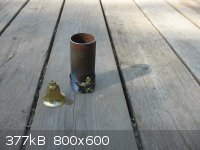 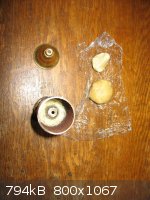 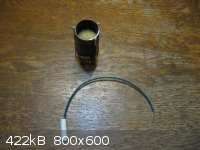 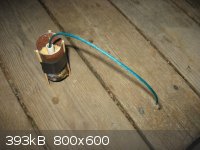 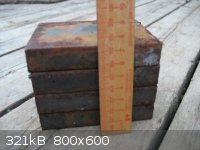 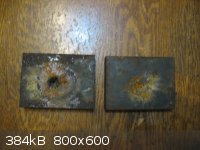 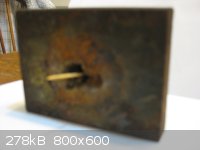 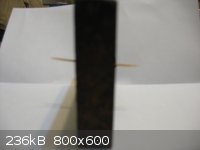 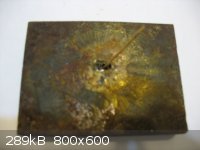
[Edited on 11-9-2011 by Hennig Brand]
|
|
|
| Pages:
1
..
29
30
31
32
33
..
68 |